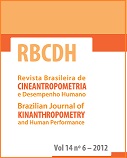Estudo da composição corporal de idosas ativas pelos métodos óxido de deutério e antropométrico
DOI:
https://doi.org/10.1590/1980-0037.2012v14n6p615Resumo
Com o envelhecimento, ocorrem alterações na composição corporal, observando-se uma redução da massa magra (MM) e um aumento progressivo da massa gorda (MG). O objetivo deste estudo foi descrever a composição corporal de mulheres idosas ativas, pelos métodos de antropometria e óxido de deutério e verificar a concordância do método antropométrico com o método óxido de deutério, considerado como referência nesse estudo. Participaram do estudo 22 idosas independentes, com faixa etária entre 65 a 75 anos. O peso corporal foi avaliado usando balança digital e a altura usando um estadiômetro em barra vertical. Para identificar o nível de atividade física foi usado o questionário internacional de atividade física (IPAQ, versão longa). A composição corporal foi avaliada pela antropometria pelas equações de Jackson et al. e Durnin e Womersley e pelo método de óxido de deutério (2H2O). Para análise estatística, usaram-se o coeficiente de concordância de Lin e o gráfico de Bland e Altman. A média de idade foi 69,3±3,6 anos, o peso 67,2±10,6Kg, a altura 1,55±0,04m e o índice de massa corporal 27,9±5,0 kg/m2. Os coeficientes de concordância obtidos pelas equações de Jackson et al. e Durnin e Womersley comparados ao deutério foram: %GC 0,72 e 0,71; MG 0,90 e 0,91; e MM 0,46 e 0,57. As equações utilizadas neste estudo apresentaram boa concordância com o deutério, sendo que, a equação de Durnin e Womersley apresentou melhores resultados para avaliar a composição corporal de idosas ativas.
Downloads
Publicado
Edição
Seção
Licença

Direitos Autorais para artigos publicados nesta revista são do autor, com direitos de primeira publicação para a revista. Em virtude da aparecerem nesta revista de acesso público, os artigos são de uso gratuito, com atribuições próprias, em aplicações educacionais e não-comerciais, desde que seja dada a atribuição. Esta obra foi licenciada com uma Licença Creative Commons Atribuição 4.0 Internacional - CC BY


